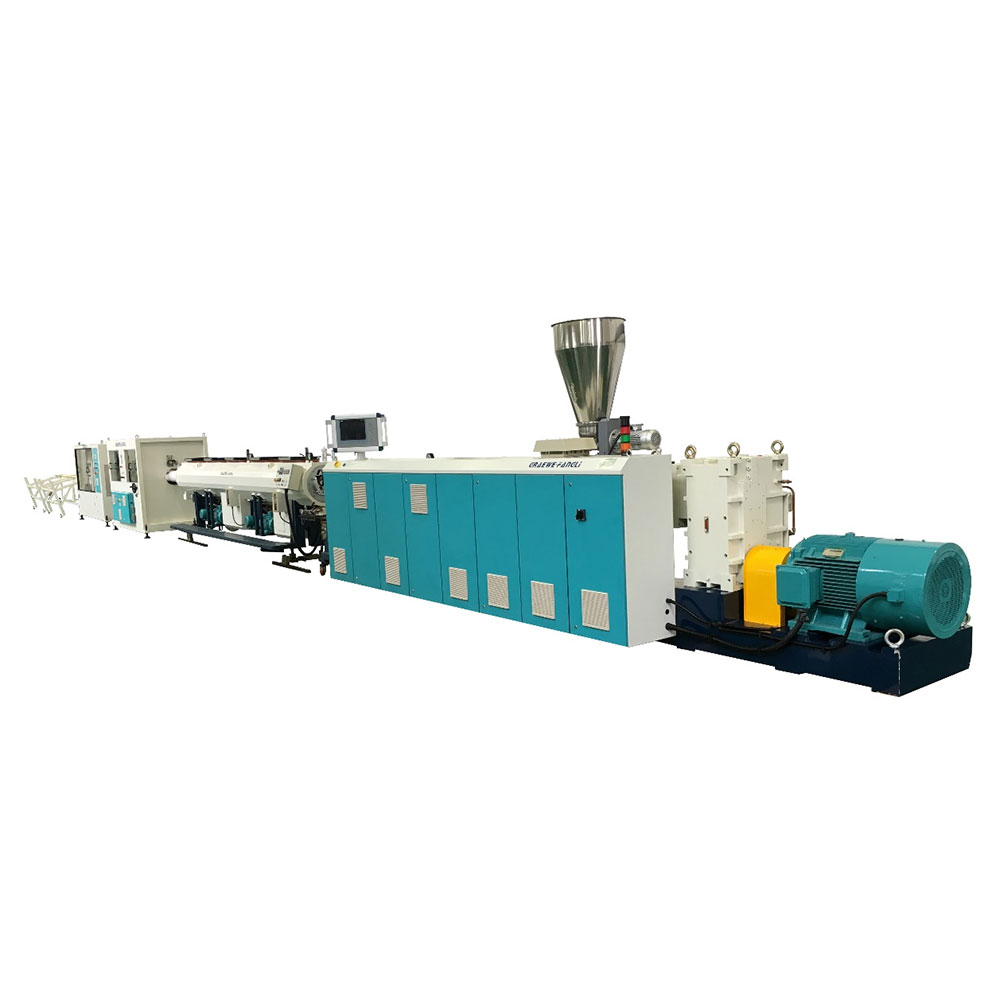Solid Wall Pipe Extrusion Line: The Key to Efficient and Durable Pipe Production
2025-03-12
The production of solid wall pipes is an essential process in various industries, including construction, plumbing, telecommunications, and agriculture. These pipes are designed to provide reliable transportation of water, gas, and other substances, and their durability and strength make them an important component of modern infrastructure. The solid wall pipe extrusion line is at the heart of this manufacturing process, enabling the creation of pipes that meet the highest standards of quality and efficiency.
In this blog, we will explore what a solid wall pipe extrusion line is, how it works, the benefits it offers, and the industries that rely on these pipes for their daily operations.
What is a Solid Wall Pipe Extrusion Line?
A solid wall pipe extrusion line is a specialized manufacturing system used to produce solid wall pipes made from various materials like PVC (Polyvinyl Chloride), HDPE (High-Density Polyethylene), and PP (Polypropylene). The extrusion process involves feeding raw plastic material through an extruder, which heats and softens the material before forcing it through a mold or die to create the desired pipe shape.
Once the molten material has been shaped, it is cooled and hardened to form a solid, strong pipe. These pipes are then cut to the required length and packaged for shipment. The entire process is highly automated, ensuring consistent quality and precise control over pipe dimensions.
Key Components of a Solid Wall Pipe Extrusion Line
A solid wall pipe extrusion line consists of several key components, each of which plays a vital role in ensuring the production of high-quality pipes. Let's take a closer look at these components:
1. Extruder
The extruder is the primary machine in the extrusion line. It melts and mixes the raw plastic material by using a rotating screw that pushes the material through a heated barrel. The extruder is responsible for ensuring the material reaches the correct viscosity for shaping.
2. Die and Head
Once the material is melted, it is forced through a specially designed die. The die gives the pipe its desired shape and size. The die head is the component that holds the die and directs the material into the mold, ensuring that the pipe has uniform thickness and quality.
3. Vacuum Calibration Tank
After the molten material exits the die, it is still in a soft form. The vacuum calibration tank helps to shape and cool the pipe by using a vacuum system that holds the pipe in place while it solidifies. The vacuum calibration tank is essential for achieving the correct dimensions and smooth surface finish of the pipe.
4. Cooling System
Once the pipe has been shaped, it is cooled down to a solid state. The cooling system, typically consisting of water or air, helps the pipe retain its shape and ensures it is fully solidified. Proper cooling is critical to prevent distortion and ensure consistent pipe quality.
5. Puller and Haul-off Unit
The puller or haul-off unit is responsible for pulling the pipe along the extrusion line at a constant speed. It ensures that the pipe maintains a consistent shape and dimension as it moves through the various stages of the extrusion process.
6. Cutting Unit
Once the pipe has been fully formed and cooled, it is ready to be cut into specific lengths. The cutting unit ensures that each piece of pipe is cut to the required length, with high precision, to meet the needs of the application.
7. Control Panel
The control panel is the central hub that manages all aspects of the extrusion process. It allows operators to monitor parameters such as temperature, speed, pressure, and cooling, ensuring that the process runs smoothly and produces pipes of the desired quality.
Benefits of Using a Solid Wall Pipe Extrusion Line
1. Durability and Strength
The extrusion process creates solid wall pipes that are highly durable and resistant to external pressures, making them ideal for demanding applications such as plumbing, sewage systems, and industrial uses. The solid structure ensures that the pipes can handle high pressure and rough handling.
2. Cost-Effective Production
Once the extrusion line is set up, it can produce large quantities of pipes efficiently and with minimal manual intervention. This high level of automation makes the process cost-effective, reducing labor costs and maximizing production output.
3. Precision and Quality Control
The extrusion line ensures that each pipe produced is consistent in terms of size, shape, and thickness. With the help of advanced monitoring systems and quality control mechanisms, manufacturers can achieve high precision, resulting in pipes that meet strict industry standards.
4. Customization
Extrusion lines for solid wall pipes allow manufacturers to produce pipes in various sizes, thicknesses, and materials. This flexibility enables the creation of pipes tailored to specific requirements, whether for plumbing, agriculture, or industrial applications.
5. Environmentally Friendly
Modern extrusion lines can use recycled plastic materials, contributing to a more sustainable production process. Additionally, the pipes produced are often recyclable, reducing the environmental impact of the manufacturing process.
Applications of Solid Wall Pipes
Solid wall pipes produced by extrusion lines are used in a wide range of applications across various industries. Some common uses include:
1. Plumbing and Water Supply
Solid wall pipes are commonly used in residential and commercial plumbing systems to transport water and other fluids. The strength and durability of these pipes make them ideal for both potable water systems and waste management.
2. Sewage and Drainage Systems
In sewage and drainage systems, solid wall pipes are essential for transporting wastewater and stormwater. Their resistance to corrosion and chemicals ensures that they can withstand harsh environments and remain effective over time.
3. Irrigation Systems
In agriculture, solid wall pipes are used for irrigation systems that deliver water to crops. The pipes' durability ensures that they can handle high-pressure water flow while withstanding exposure to the elements.
4. Telecommunications
In telecommunications, solid wall pipes are used as conduits to protect cables and wiring. These pipes prevent damage to the cables and provide a safe, secure path for communication lines.
5. Industrial Applications
Solid wall pipes are also used in various industrial applications for transporting chemicals, gases, and other materials. Their resistance to wear, tear, and chemicals makes them suitable for use in manufacturing plants, refineries, and other industrial facilities.
Conclusion
The solid wall pipe extrusion line is a critical piece of technology in the manufacturing of high-quality, durable pipes. By utilizing automated processes, extrusion lines can efficiently produce pipes that meet the needs of various industries. The combination of strength, flexibility, cost-effectiveness, and sustainability makes solid wall pipes an essential product for plumbing, agriculture, telecommunications, and industrial sectors.
As industries continue to demand high-performance materials, extrusion technology will play an increasingly important role in ensuring that solid wall pipes remain an integral part of modern infrastructure.



